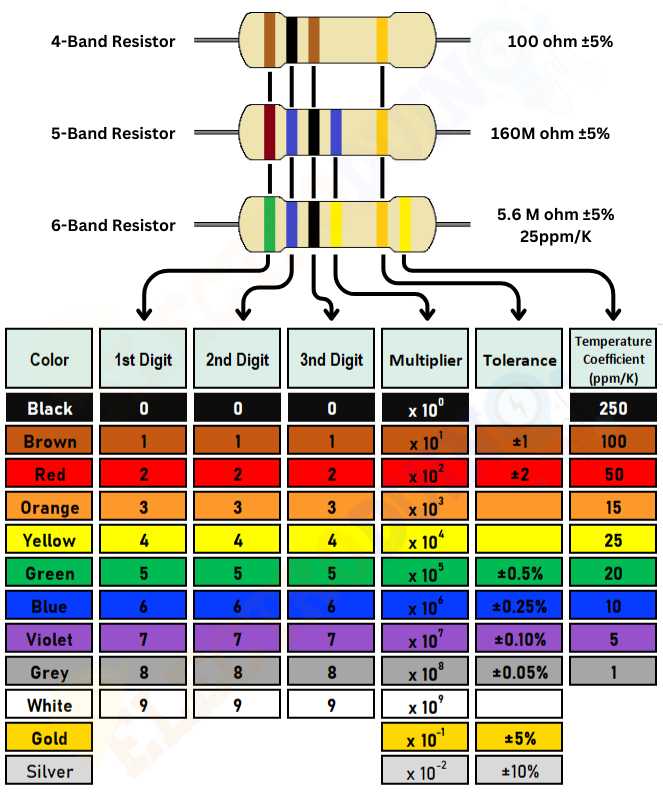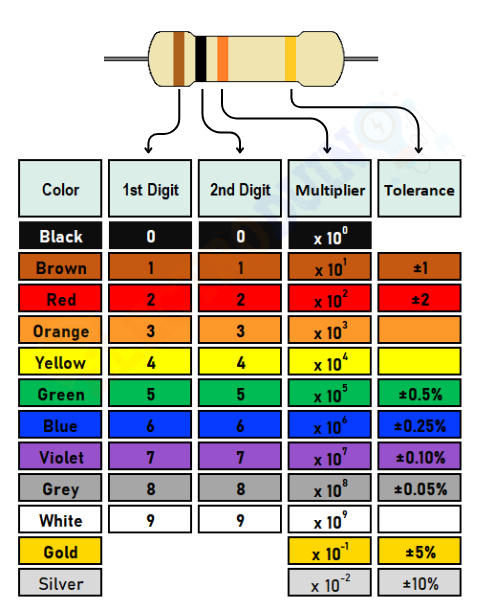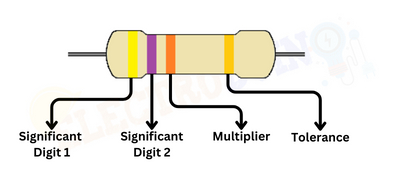Resistor Color Code Trick | 4 Band Resistor Color Code
Hello friends! Welcome back to ElectroDuino. In the last tutorial, we discussed “What is Resistor: Definition, Types, Symbol, Color Code, Circuit, Application“ and “Types of Resistors and they are Construction, Symbol, and Applications“. This basic electronics blog tutorial is based on the Resistor Color Code Trick | 4 Band Resistor Color Code. In this article, we will discuss What is a Resistor Color Code, Color Code Chart, 4-Band Resistor Color Code, How to Read and Calculate Resistor Color Code, Examples.
Introduction
In the world of electronics, resistors are a passive electronic component that is responsible for controlling current flow in electronic Circuits. They come in various resistance values that dictate their function in circuits. While these values can be measured with an instrument called the ohmmeter, the resistor color code offers a rapid visual method to determine the resistance rating.
What is a Resistor Color Code?
Resistor color code is a system used to indicate the resistance value of a resistor through a sequence of colored bands that encircle the resistor’s body. It’s a visual system that represents a resistor’s resistance value, tolerance, and sometimes even its temperature coefficient. This Coding system is internationally standardized by IEC 60062 and widely recognized in the electronics industry, allowing engineers and enthusiasts to quickly determine the resistance value of a resistor without the need for specialized equipment.
There are three types of resistor color bands: 4-band resistor, 5-band resistor, and 6-band resistor.

Also Read:
- Resistor: Definition, Types, Symbol, Color Code, Circuit, Application
- Types of Resistors: Construction, Symbol, and Applications
- Resistance – What is it? Definition, Unit, Symbol, Law, Formula
Resistor Colour Code Chart / Color Code Table
The Resistor Color Code Chart was devised as a standardized method to mark resistors, ensuring clarity and consistency in the electronic industry. Introduced in the early 20th century, this system revolutionized the way engineers and technicians identified and sorted resistors, simplifying the manufacturing and repair processes significantly.
The colors themselves are not randomly assigned; rather, they follow a standardized sequence: black, brown, red, orange, yellow, green, blue, violet, gray, and white. Each color corresponds to a specific digit.

- Tolerance: The Resistor Color Code Chart not only provides the resistance value but also indicates the tolerance level. Common tolerance values include 1%, 2%, 5%, and 10%. A lower tolerance signifies higher precision, crucial in applications where accuracy is paramount.
- Temperature Coefficients: The Resistor Color Code Chart also accommodates specialized resistors, including those with temperature coefficients. This value indicates how much the resistor’s resistance will change with temperature. It is often expressed in parts per million per degree Celsius (ppm/°C). By understanding additional color bands, engineers can identify resistors designed for specific temperature-dependent applications.
How to Remember Resistor Color Codes (Mnemonic)
Remembering resistor color codes can be a difficult task due to the variety of colors and their specific meanings. Mnemonics, memory aids that use associations and patterns can be a helpful tool in making this task more manageable. Associate the first letters (bold letters) of each word with the significant digits in the order they appear on the resistor.
Here are mnemonics for both the 4-band resistor color codes:
“BB ROY of Great Britain had a Very Good Wife,”
“Better Be Right Or Your Great Big Venture Goes West”
Understanding the 4-Band Resistor Color Code
A 4-band resistor typically consists of four colored bands placed around its cylindrical body. Each band represents a specific value or multiplier that, when combined, provides the resistance of the resistor.

First Color Band (Significant Digit 1): The first band represents the first significant digit of the resistance value. Each color corresponds to a specific digit, allowing you to determine the initial digit. For example, black represents 0, brown represents 1, red represents 2, and so on.
Second Color Band (Significant Digit 2): Similar to the first band, the second color band represents the second digit of the resistance value. By associating colors with numbers, you can identify the second digit.
Third Color Band (Multiplier): The third band denotes the multiplier, indicating the power of ten by which the first two digits should be multiplied. For example, if the band is orange (representing 10^3 or 1,000), the resistance value would be in the thousands.
Fourth Color Band (Tolerance ): The fourth band signifies the tolerance level of the resistor. Tolerance indicates the range within which the actual resistance value may vary from the stated value. Common tolerance values are represented by colors such as brown (±1%), red (±2%), gold (±5%), and silver (±10%).
How to Read and Calculate Resistor Color Code
Let’s delve into the step-by-step process of decoding this colorful enigma.

Step 1: Identify the Resistor Color Bands
Examine the resistor’s color bands and note down the colors from left to right. The first two bands on the resistor represent significant digit 1 and significant digit 2. The third band signifies the multiplier, indicating the power of 10 by which the significant digits are multiplied. The color of each band corresponds to a numerical value based on a standard color chart.
Step 2: Assign Numerical Values
Refer to the color code chart to assign numerical values to each color:
- First Band (Color A): Significant Digit 1
- Second Band (Color B): Significant Digit 2
- Third Band (Color C): Multiplier
- Fourth Band (Color D): Tolerance
Step 3: Calculate the Resistance Value
Combine the numerical values assigned to Color A and Color B to get the significant digits. Multiply this value by the multiplier (Color C). This gives you the resistance value in ohms. The 4 Band Resistor Color Code Formula to calculate resistance value is as follows:
Resistance (ohms) = (Significant Digit 1 * 10 + Significant Digit 2) * 10^Multiplier
Step 4: Determine Tolerance
The tolerance band (Color D) indicates the allowable percentage deviation from the calculated resistance value. The fourth band represents the tolerance of the resistor, indicating the permissible range of deviation from the specified resistance value. Different colors correspond to different tolerance levels. Consult the color chart to determine the tolerance associated with the color of the fourth band.
Step 5: Final Result
Combine the results from steps 3 and 4 to obtain the final resistance value. For example, if the resistance is 120 ohms and the tolerance is ±5%. So we can write the Resistor’s resistance value as 120 ohm ±5%
Learning with an example
4 Band Resistor Color Code Example
Using a practical example we have explained how to calculate the resistance value step by step. Consider a 4-band resistor with the color bands Red, Violet, Orange, and Gold.

Step 1: Identify the Colors
- Significant Digit 1 (1st Band): Red
- Significant Digit 2 (2nd Band): Violet
- Multiplier (3rd Band): Orange
- Tolerance (4th Band): Gold
Step 2: Assign Numerical Values
Using the color code chart assign numerical values to each color
- Red: 2
- Violet: 7
- Orange: 10^3 = 1000
- (Gold): ±5%
Step 3: Calculate the Resistance Value
Using the 4 Band Resistor Color Code formula, the resistance value is calculated as:
Resistance (ohms) = (Significant Digit 1 x 10 + Significant Digit 2) * 10^Multiplier
Resistance = (2×10 + 7) × 10^3
= (2×10 + 7) × 1000
= 27000 ohm
= 27kΩ [∵1000Ω = 1k]
Step 4: Determine Tolerance
Tolerance (4th Band): Gold
So, the resistor has a tolerance of ±5%, meaning the actual resistance could vary by ±5% from the calculated value.
Step 5: Final Result
Finally, we can write Red, Violet, Orange, and Gold color coded Resistor value is 27kΩ ±5%
Why is the Resistor Color Code Important?
- Quick Identification: The resistor color code allows engineers to swiftly identify the resistance value of a resistor without needing to use measuring instruments. This efficiency is particularly useful during circuit design, troubleshooting, and repairs.
- Consistency and Universality: The color code is standardized globally, ensuring uniformity in communication across the electronics industry. Regardless of language or location, engineers can decipher the resistance value accurately.
- Practical Application: Understanding the resistor color code is not just theoretical; it’s a skill used daily in electronics design and repair. Mastery of this system empowers individuals to confidently work with resistors, making accurate calculations and decisions.
- Efficient Circuit Design: Engineers and technicians use the color code to select resistors suitable for specific applications, ensuring precise resistance values in electronic circuits.
- Component Replacement: When repairing or modifying electronic devices, hobbyists and technicians rely on the color code to replace resistors accurately, maintaining the intended circuit behavior.
- Speed and Accuracy: Calculating resistance values manually can be time-consuming and prone to errors. Using the color code and a calculator ensures accuracy and saves time.
- Educational Value: Learning how to decode resistor color codes enhances your understanding of electronics and allows you to work confidently with resistors.
Calculate Resistor Color Code Examples
Example 1: Calculate the resistance value of a resistor with the color bands (Code) Brown, Black, Brown, and Gold.

- Brown (Digit 1): 1
- Black (Digit 2): 0
- Brown (Multiplier): 101
- Gold (Tolerance): ±5%
Calculate Resistance Value
Using the color code formula, the resistance value is calculated as:
Resistance (ohms) = (Significant Digit 1 x 10 + Significant Digit 2) * 10^Multiplier
Resistance = (1×10 + 0) × 101
= 100 Ω
So, the Brown Black Brown Gold Resistor value is 100Ω ±5%
Example 2: Calculate the resistance value of a resistor with the color bands (Code) Brown, Green, Brown, and Gold.

- Brown (Digit 1): 1
- Green (Digit 2): 5
- Brown (Multiplier): 101
- Gold (Tolerance): ±5%
Calculate Resistance Value
Using the color code formula, the resistance value is calculated as:
Resistance (ohms) = (Significant Digit 1 x 10 + Significant Digit 2) * 10^Multiplier
Resistance = (1×10 + 5) × 101
= 150 Ω
So, the Brown Green Brown Gold Resistor value is 150Ω ±5%
Example 3: Calculate the resistance value of a resistor with the color bands (Code) Red, Red, Red, and Gold.

- Red (Digit 1): 2
- Red (Digit 2): 2
- Red (Multiplier): 102
- Gold (Tolerance): ±5%
Calculate Resistance Value
Using the resistor color code formula, the resistance value is calculated as:
Resistance (ohms) = (Significant Digit 1 x 10 + Significant Digit 2) * 10^Multiplier
Resistance = (2×10 + 2) × 102
= 2200 ohm
= 2.2kΩ [∵1000Ω = 1kΩ]
The resistor has a tolerance of ±5%, implying the actual resistance could vary by ±5% from the calculated value.
So, the Red Red Red Gold Resistor value is 2.2kΩ ±5%
Example 4: Calculate the resistance value of a resistor with the color bands (Code) Yellow, Violet, Orange, and Gold.

- Yellow (Digit 1): 4
- Violet (Digit 2): 7
- Orange (Multiplier): 103
- Gold (Tolerance): ±5%
Calculate Resistance Value
Using the color code formula, the resistance value is calculated as:
Resistance (ohms) = (Significant Digit 1 x 10 + Significant Digit 2) * 10^Multiplier
Resistance = (4×10 + 7) × 103
= 47000 ohm
= 47kΩ [∵1000Ω = 1kΩ]
So, the Yellow Violet Orange Gold Resistor Value is 47kΩ ±5%
Example 5: Calculate the resistance value of a resistor with the color bands (Code) Brown, Black, Green, and Gold.

- Brown (Digit 1): 1
- Black (Digit 2): 0
- Green (Multiplier): 105
- Gold (Tolerance): ±5%
Calculate Resistance Value
Using the color code formula, the resistance value is calculated as:
Resistance (ohms) = (Significant Digit 1 x 10 + Significant Digit 2) * 10^Multiplier
Resistance = (1×10 + 0) × 105
= 1000000 ohm
= 1MΩ [∵106 Ω = 1MΩ]
So, the Brown Black Green Gold Resistor Value is 1MΩ ±5%


